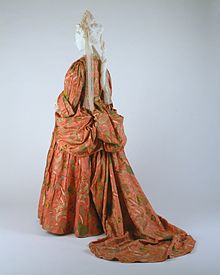Our website is made possible by displaying online advertisements to our visitors.
Please consider supporting us by disabling your ad blocker.
Mantua (clothing)

A mantua (from the French manteuil or 'mantle') is an article of women's clothing worn in the late 17th century and 18th century. Initially a loose gown, the later mantua was an overgown or robe typically worn over stays, stomacher and either a co-ordinating or contrasting petticoat.
The mantua or manteau was a new fashion that arose in the 1670s. Instead of a bodice and skirt cut separately, the mantua hung from the shoulders to the floor (like dresses of earlier periods). It started as the female version of the men's banyan, worn for "undress" wear. Gradually the mantua developed into a draped and pleated dress and eventually evolved into a dress worn looped and draped up over a contrasting petticoat and a stomacher. The mantua-and-stomacher resulted in a high, square neckline in contrast to the broad, off-the-shoulder neckline previously in fashion. The new look was more modest and covered-up than previous fashions and decidedly fussy, with bows, frills, ribbons, and other trim, but the short string of pearls and pearl earrings or "eardrops" worn since the 1630s remained popular.
The mantua, made from a single length of fabric pleated to fit with a long train, was ideal for showing the designs of the new elaborately patterned silks that replaced the solid-coloured satins popular in the mid-century.[1]
As well as contributing a new style of gown to women's dress, which would remain popular through the 18th century, the mantua formalised women dressmakers' and seamstresses’ position as makers of outerwear.[2]
- ^ Ribeiro, Aileen, on the origins of the mantua in the late 17th century, in Dress in Eighteenth Century Europe 1715–1789; Ashelford, Jane, The Art of Dress
- ^ Bendall, Sarah A. (2023-04-16). "The queens' dressmakers: women's work and the clothing trades in late seventeenth-century London". Women's History Review. 32 (3): 389–391. doi:10.1080/09612025.2022.2136197. ISSN 0961-2025. S2CID 258301721.
Previous Page Next Page


